Concave and Convex Mirrors
What is a Mirror?
A mirror is a reflective surface that reflects the light coming from an object and thus forms an image either real or virtual. Whenever an object is placed in front of a mirror, light coming from every part of the object falls on the mirror and gets reflected from the reflective surface and on the points where all the reflected light rays get intersected with each other, it forms an image of the same object which can be seen in the mirror.
- What is a Mirror?
- Types of Mirrors
- Concave Mirror Definition, Properties
- Convex Mirror: Definition, Properties.
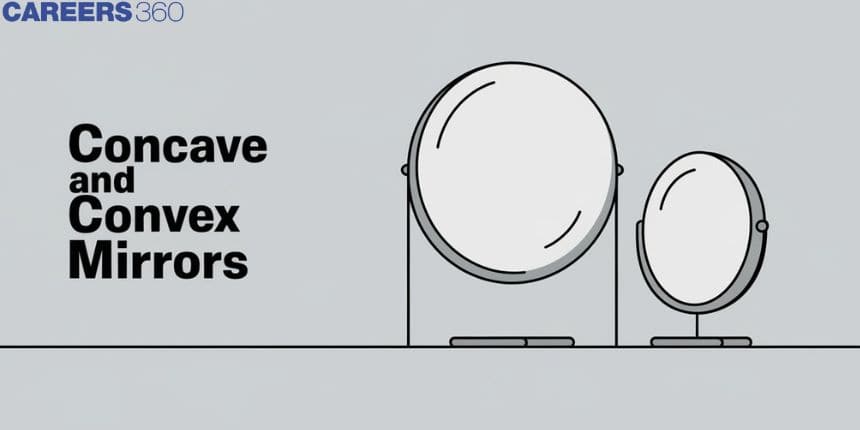
A real image is one when the reflected rays of light from the mirror intersect in actual places and thus these intersection points in space form the complete image of the object, whereas A virtual image is one when the reflected rays of light don’t intersect in actual places but we choose the points in space where these rays will meet apparently.
Types of Mirrors
- Plane Mirror
- Spherical Mirror
A plane mirror is one whose reflecting surface is flat and smooth and a plane mirror always forms a virtual image of all objects kept in front of the mirror and images formed by a plane mirror are virtual, and of the same size as the object.
Those types of mirror whose reflecting surface is curved are known as spherical mirrors. Spherical mirrors are generally made by cutting a sphere in two parts which results in two curved surfaces and when one side of the curved surface is polished, it acts as a spherical mirror. Spherical mirrors are generally of two kinds: Concave mirror and Convex mirror.
Now, we will discuss Concave mirrors and convex mirrors in detail and image formation by these mirrors in each different position of an object.
Also read -
- NCERT Solutions for Class 11 Physics
- NCERT Solutions for Class 12 Physics
- NCERT Solutions for All Subjects
Concave Mirror Definition, Properties
What is a concave mirror and give concave mirror examples.
If we cut a hollow sphere into two parts and then if we paint the outer surface of the cut part then it behaves as a mirror whose reflecting surface is bent inwards and such types of mirrors are known as Concave mirrors.
Properties of Concave Mirror:
-
Light coming from infinity parallel to the principal axes converges at a point after the reflection which is called the focus of the concave mirror and thus the Concave mirror is also called the Converging mirror.
-
When an object is placed between the Focus and Pole of the concave mirror, it forms a virtual image which is the only case when a concave mirror produces virtual image otherwise always produces a real image.
-
If an object is placed at focus on the principal axes of the concave mirror, it will produce an image at infinity of very large size.
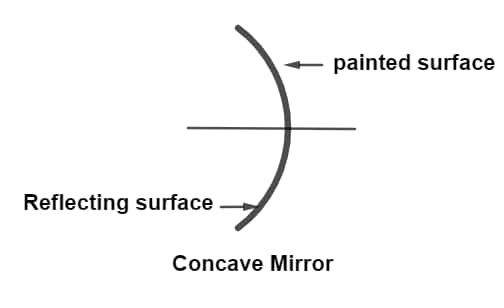
Convex Mirror: Definition, Properties.
What is a convex mirror?
If we cut a hollow sphere into two parts and then if we paint the inner surface of the cut part then it behaves as a mirror whose reflecting surface is bent outwards and such types of mirrors are known as Convex mirrors.
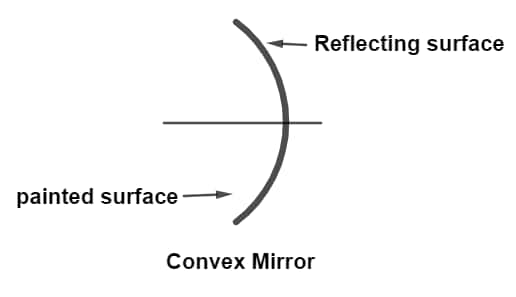
(Source: Geogebra)
Properties of Convex Mirror:
-
Light coming from the infinity parallel to principal axes will diverge after reflection thus Convex mirror is also known as a Diverging mirror.
-
A convex mirror always produces a virtual and erect image whatever be the position of the object.
-
The convex mirror forms the very small-sized convex mirror image of an object only once if the object is placed at infinity and the image is formed at the focus of the convex mirror.
Rules for Ray diagrams for concave and convex mirrors.
-
Any light ray coming parallel to the principal axes will pass through the focus of the concave mirror and convex mirror.
-
Any light ray striking the pole of the concave mirror and a convex mirror at any angle will get reflected with the same amount of angle.
-
Any light ray passing through the focus of the concave mirror or convex mirror, will reflect from the mirrors in a direction parallel to the principal axes.
-
Any light ray passing through the Centre of curvature of the concave or convex mirror, will reflect back to the same path along the center of curvature of the mirrors.
Image Formation By Concave mirrors at different locations:
There are 6 cases of concave mirrors where objects can be placed and different locations of images can be seen, they are listed as:
-
When the object is at infinity
-
When the object lies between the Focus and the Pole of the mirror.
-
When an object is located between Focus and Centre of curvature.
-
When the object lies at Focus.
-
When an object lies at the center of curvature
-
When an object lies beyond the center of curvature
Various Image formation by a concave mirror is shown by using convex mirror ray diagram rules as:
Here, the notions are named as O represents Object position, I represents image position, P represents Pole, F represents Focus, C represents Centre of curvature.
-
Image Formation by the concave mirror when the object lies at infinity. The image formed is real and has a very small size and formed at the focus of the concave mirror.
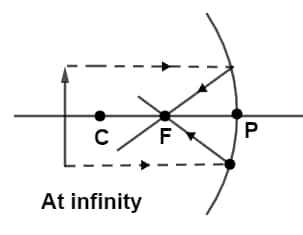
-
When an object lies between the Focus and the pole. The image formed is virtual and erect and has a size larger than the object.
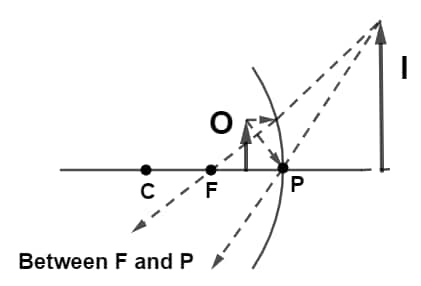
-
When the object lies between the Focus and the center of curvature. The image formed is Real and inverted and has a size larger than the object.
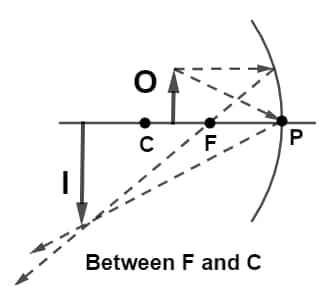
-
When the object lies at Focus. The image formed is at infinity and the image is real and much larger than the size of the object.
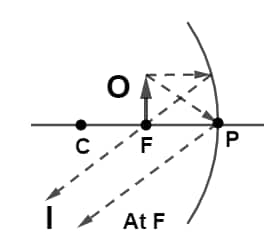
-
When the object lies at the Centre of curvature. Image formed is real and inverted and has the same size as that of the object.
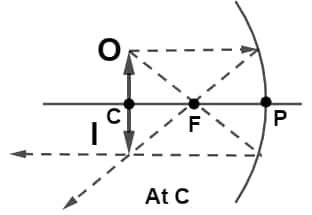
-
When an object lies beyond the center of curvature. The image formed is real and inverted and has a small size to that of the object and lies between focus and center of curvature.
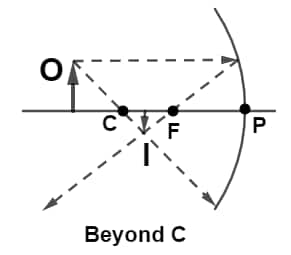
Image Formation By Convex mirrors at different locations:
The nature of image formed due to convex mirrors is always virtual and erect. We have only two major cases to discuss in image formation due to convex mirrors. They are listed as:
-
When an object is at infinity.
-
When an object is placed at any finite distance from the pole of the convex mirror.
Various Image formation by a convex mirror is shown by using ray diagram rules:
-
When an object is at infinity. The image formed is virtual and erect with a very small size to that of the object and formed at the focus of the convex mirror.
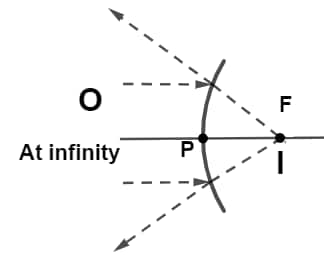
-
When an object is placed at any finite distance from the pole. The image formed is virtual and erect and will form between the pole and focus of the convex mirror but is small in size to that of the object.
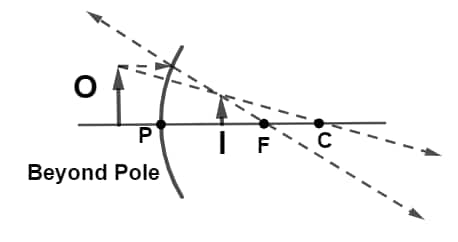
|
S. No |
Object’s Position |
Image Position |
Size of Image compared to object |
Nature of Image |
|
1 |
At infinity |
At Focus |
much smaller |
Real |
|
2 |
Between P and F |
Behind the mirror |
Large |
Virtual |
|
3 |
Between F and C |
Beyond Centre of curvature |
Large |
Real |
|
4 |
At Focus |
At infinity |
much Larger |
Real |
|
5 |
At the Centre of curvature |
At the Centre of curvature |
same size |
Real |
|
6 |
Beyond Centre of curvature |
Between Focus and Centre of curvature |
small |
Real |
The various positions of the object and their location, the nature of image formation by a convex mirror are summarized in the table given below:
|
S. No |
Object’s Position |
Image Position |
Size of image compared to the object. |
Nature of image |
|
1 |
At infinity |
At focus |
much smaller |
Virtual |
|
2 |
Beyond Pole at any finite distance |
Between Pole and focus |
small |
Virtual |
Also check-
Frequently Asked Questions (FAQs)
A concave mirror is a converging mirror and depending upon the locations of an object on principal axes of the concave mirror, It forms either a Real and inverted image or a Virtual and erect image. Virtual and erect is formed in only one condition when the object is placed between Focus and the pole of the concave mirror, otherwise always forming a real and inverted image. A convex mirror is a diverging mirror and it always forms only Virtual and erect images irrespective of the position of an object on the principal axes of a convex mirror.
A concave mirror produces a real image of the object and produces an inverted and virtual image if the object is placed very close to it, so put an object in front of the mirror and observe the nature of the image if it’s real and inverted then it is a concave mirror whereas if the image is virtual at any position of the object then, the mirror is a convex mirror and convex mirror always produce a virtual and erect image of the object.
Plane mirrors are those mirrors whose reflecting surface is flat and smooth and plane mirrors always produce the image of the object behind the mirror at the same distance as that of object distance from mirror and image formed by a plane mirror is of the same size as that of object’s size. whereas Concave and convex mirrors are types of spherical mirrors. A concave mirror is one whose reflecting surface is bent inwards and the outer curved part is polished whereas a convex mirror is one in which the reflecting surface is bent outwards and the inner surface is polished. Plane mirrors have zero radii of curvature but concave and convex mirrors have the same definite value of their radius of curvature.
Also Read
19 Jul'25 03:20 PM
02 Jul'25 07:56 PM
02 Jul'25 06:11 PM
02 Jul'25 05:17 PM
02 Jul'25 05:09 PM
02 Jul'25 05:08 PM
02 Jul'25 05:08 PM
02 Jul'25 05:07 PM
02 Jul'25 05:07 PM
02 Jul'25 05:04 PM